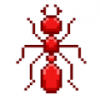As some of you may know, I have been working on developing a little, fledgling S. molesta colony with 10 queens. I am quite proud of it so far. It got its first set of workers 3 days ago and since then the population has swelled to about 22 workers with new ones eclosing every day. The brood pile has grown pretty large as well. Unfortunately, one of the queens went awol and decapitated one of the other queens and dismembered another while I was off getting some home work done. S. molesta is known for being polygyne, but some individuals will result to pleometrotic founding as well. The two founding behaviors may result from a sort of genetic component : certain individuals may be genetically predisposed to favor either founding strategy, allowing them (as a species, not as individuals.) to survive under a wider variety of conditions / scenarios (certain instances / scenarios may favor either founding strategies over the other). This also may result from relatedness (Queens that come from the same / nearby colonies will share a more similar cuticular hydrocarbon composition when compared to those from distant / geographically foreign colonies. This may be the trigger instead.) Anyways, theories aside, the queen that was decapitated continued moving after the incident. The workers began to attach larvae to her thorax, but after an hour or so, all of the larvae were removed. Instead of discarding the queen like they did with the other, they would routinely clean it. The decapitated queen was often unbalanced and unable to stand, but occasionally did so under her own power. Unable to remove her without disturbing the colony and seeing that it wasn't doing any harm, I left her for the time being. It has been five days and she is still active!!! She actually appears to me active than before! It goes without saying that although the centralized brain of insects is required for most higher forms of function, some individuals may be able to survive with the use of their nerve cord / ganglia alone. I'm wondering if the workers are possibly feeding her somehow and if she is still laying eggs...
I have never had anything like this happen before and was pretty shocked when I found out what was happening. Thought I should share it with you guys. Maybe some of you have had similar experiences.













